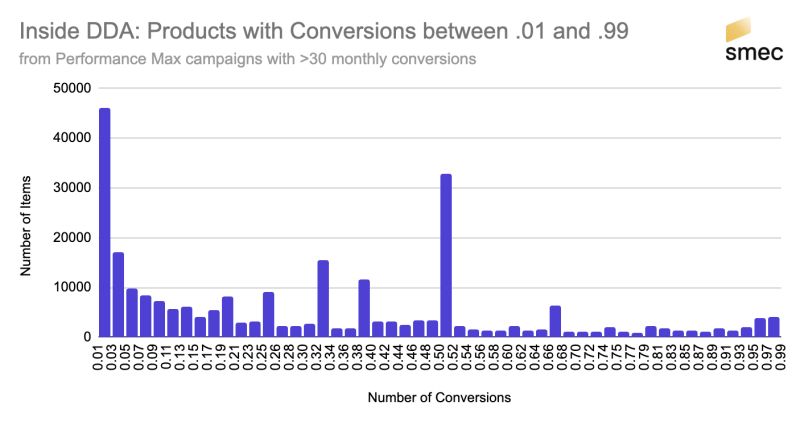Subscribe to join thousands of other ecommerce experts

At first glance, data-driven attribution (DDA) in Google Ads might seem like just another fancy tool. But don’t be fooled by the dry charts—there’s more to it than meets the eye. The world of attribution has recently undergone a significant transformation, with Google discontinuing most rule-based models (goodbye, first-click and linear!) and leaving us with only two: last-click and their much-lauded DDA. While DDA promises to make sense of today’s complex conversion paths, it’s not without its quirks. Let’s break down what you need to know about how DDA really operates—and what that means for your campaigns.
Table of Contents
Why did Google go all-in on data-driven attribution?
With the demise of rule-based models like first-click and position-based, advertisers are left with DDA as the shining beacon of multi-touch attribution. Google touts it as a sophisticated, AI-powered approach that uses historical account data to allocate conversion credit more fairly across touchpoints. Unlike last-click, which basically hands all the credit to the final touch, DDA spreads the love across the customer journey.
Sounds great, right? Well, here’s the rub. The transparency that rule-based models offered is largely absent in DDA, which has become another layer in Google’s infamous “black box.” Sure, DDA promises to shine light on those elusive upper-funnel interactions, but at what cost? Advertisers have less control over how conversions are attributed—Google’s algorithm makes the call, and it’s not always clear why.
The Kissed-By Attribution problem
Recently, we analyzed more than 280,000 items within Performance Max (PMax) campaigns, focusing on fractional conversions. It was part of a broader effort to understand how DDA is actually playing out in the real world. We found that a significant chunk of conversions were being credited with only 0.01% to 0.99% of a sale—a phenomenon we’ve dubbed “Kissed-By Attribution.”

It includes only Performance Max campaigns with more than 30 monthly conversions
Here are the key takeaways from that analysis:
- Small decimals rule the day: The majority of fractional conversions skew toward tiny decimals, less than 0.5% attribution. This tells us that DDA is doing its job, allocating small slices of credit to upper- and mid-funnel touchpoints, which is arguably what you want if you’re trying to avoid an overly short-term focus. In theory, this is how DDA should work: nurturing longer, multi-step journeys.
- The 1% kiss: But here’s where things get weird. The single biggest chunk of fractional conversions? Exactly 0.01. Imagine an item getting only 1% credit for a conversion—it suggests that the campaign was barely involved. This pattern is widespread, and it looks suspiciously like DDA padding revenue with near-meaningless contributions. This “kissed-by” credit might boost your numbers but doesn’t really indicate strong campaign impact.
- Suspiciously clean fractions: We also noticed clusters of conversions with clean decimal fractions, like one-third or one-half, which strongly suggest that when there’s a lack of solid data, the algorithm falls back on simple heuristics. Yes, the very thing it was supposed to replace.
- It’s not just minor revenue: These fractional conversions aren’t a small slice of the pie—they make up anywhere from 4% to 22% of total revenue in some PMax campaigns. And in extreme cases, they even hit 64%. And here’s the kicker: these numbers are just the minimum. More significant items, which also have fractions under one, are potentially hidden in the mix, meaning your revenue might be more “kissed-by” than you’d expect.
DDA is both a boon and a burden
On the one hand, DDA is an excellent concept, in theory. It offers the potential to fairly credit all the touchpoints in a multi-step conversion journey. This can prevent overly focusing on short-term wins at the expense of long-term growth, especially in PMax campaigns, where upper-funnel touches are vital.
On the other hand, DDA can also make things murkier for advertisers. By giving Google even more control over attribution, you lose the clear logic behind how conversions are attributed. And when you spot patterns like the 1% “Kissed-By Attribution,” it’s natural to wonder whether Google’s algorithm is inflating its own results.
While the analysis in this article focuses on Performance Max (PMax) campaigns, it’s important to note that the phenomenon described—the distribution of fractional conversions and the potential for “Kissed-By Attribution”—is not exclusive to PMax. This is a general characteristic of Google’s Data-Driven Attribution (DDA) model, which applies also to Standard Shopping, not just PMax campaigns.
What should you do?
- Stay skeptical: While DDA’s fractional conversions offer valuable insights into your full funnel, keep a critical eye on those decimals, especially the 0.01s that look more like puffery than substance.
- Cross-check your data: Relying on Google’s black-box algorithm alone can lead to skewed conclusions. Integrate your first-party data and conduct deep-dives on revenue to identify where DDA might be padding the stats.
- Balance the short and long-term: DDA can prevent your campaigns from focusing too heavily on bottom-funnel conversions, but be sure that it’s not giving credit where credit isn’t due. A granular understanding of your campaigns will help you allocate budget more effectively.
In the end, DDA is a valuable tool for understanding complex customer journeys. But it’s not without its limitations. Stay sharp, keep analyzing your data, and remember that while Google’s AI is powerful, it still needs your strategic guidance to drive meaningful outcomes.
At smec, we know that making informed decisions and aligning your advertising strategy with your business goals is the key for performance. Our expert PPC team is here to help you navigate these complexities and get the most out of your campaigns. Reach out to learn how we can support you with our software solutions and expert services.

